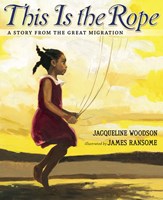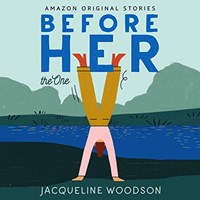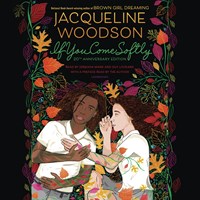Get our Newsletter
-
- Reviews
- Narrators
-
Features
- Audiobook ClubStart a conversation with your book club
- Best Audiobooks2023 Best Audiobooks
- ArticlesDiscover the diverse voices of audiobooks
- NarratorsSpotlight on popular narrators
- AuthorsAuthors talking about their audiobooks
- Upcoming TitlesFind upcoming audiobook release announcements
- Kids and TeensListening selections for kids & teens with age levels
- Audie Awards 2024 Audie Awards
- Subscribe
- About
- Articles
Jacqueline Woodson was a storyteller even as a child--although when she was younger, she says, these stories weren’t the “once-upon-a-time kind,” but more outright lies, tall tales she told to see just how much she could get away with. “It wasn’t malicious,” she laughs. “I just loved to engage people with stories from a young age, and I didn’t know how else to do it.”
These days, she’s a widely respected author of over two dozen books whose work has been honored with a Margaret A. Edwards Award for lifetime achievement, along with multiple Newbery Honors, Coretta Scott King Awards, and National Book Awards. Woodson delights in getting to do the work she loves each day. She’s usually working on a variety of creative projects, which means she can never be stuck--she just shifts gears and works on something else. “I think it’s important for writers to be still and let the information come to them and be open to ideas, but I also think it’s important to be focused and moving forward and innovative. You can have both--there are a lot of hours in the day, and there’s a time for the stillness and a time to get busy!”
A vital part of that busy creative process, Woodson says, is reading her work aloud. “Everything I write, I read out loud. It has to not only look a certain way on the page but it has to sound a certain way. And that’s how I edit--because if it’s not sounding right, then it’s not going to read right. I have a lot of my work memorized because of the reading and the rereading of it out loud. I just need to hear how it sounds.”
Perhaps because this read-aloud process creates an intense sense of familiarity with her writing, Woodson says she finds it hard to listen to other narrators’ recordings of her stories. “It never sounds like it sounds to me when I’m reading it,” she explains. “I can listen to the ones that are narrated by guys more easily than those by women, but it’s always a slight disconnect for me.”
As an audiobook listener, Woodson is drawn more to nonfiction--“stuff where I need to keep facts in my head and think about dates and information.” And as the parent of two children, she’s also grateful for the entertainment value audiobooks provide. “We’re about to drive to Vermont for six hours, and I’m glad we’ll have a carful of audiobooks with us. It’s a way for us to engage and be thoughtful about literature without me having to stop and read to them.”
Woodson very much admires all that professional narrators bring to their work. “They have to deliver so much--the visual and the physical, this whole other dimension.” She says narration is a gift she doesn’t have. She revels in reading her work aloud to live audiences, though, when on school visits, where she can see her listeners and interact with them. On frequent author visits to schools, she always begins by reading aloud as a way to cultivate a connection with her audience before talking to them about her writing. “For me, the heart of how you build a connection is by creating characters that people feel engaged with and want to follow. So for me, that’s my in, and then I can talk to them about what I do and why I do it.”
Creating a diverse picture of the world in which children can find images of themselves is an essential creative priority for Woodson. “I feel like it’s so important to give children mirrors. I write across so many lines of race and class and gender, and all of these perspectives matter. It’s so important that kids see themselves in the literature. I think it can be a really dangerous thing when young kids lack mirrors of themselves in the world, when they lack a sense of who they are. When I’m writing for them, reading to them, I’m saying: Here you are, and you matter.--Jessie C. Grearson
APR/MAY 13
© AudioFile 2013, Portland, Maine
Photo © Marty Umans
SoundReviews
Videos
Photo by Marty Umans
The latest audiobook reviews, right in your inbox.
Get our FREE Newsletter and discover a world of audiobooks.




















